Class 2:改善深层神经网络:超参数调试、正则化以及优化
Week 1:深度学习的实践方面
目录
1初始化
一个好的初始化:
能加快梯度下降的收敛速度
能增加梯度下降收敛到较低的训练误差(泛化误差)的概率
1.1辅助函数及数据集
init_utils.py
import numpy as np
import matplotlib.pyplot as plt
import h5py
import sklearn
import sklearn.datasets
def setcolor(x):
color=[]
for i in range(x.shape[1]):
if x[:,i]==1:
color.append('b')
else:
color.append('r')
return color
def sigmoid(x):
"""
Compute the sigmoid of x
Arguments:
x -- A scalar or numpy array of any size.
Return:
s -- sigmoid(x)
"""
s = 1/(1+np.exp(-x))
return s
def relu(x):
"""
Compute the relu of x
Arguments:
x -- A scalar or numpy array of any size.
Return:
s -- relu(x)
"""
s = np.maximum(0,x)
return s
def forward_propagation(X, parameters):
"""
Implements the forward propagation (and computes the loss) presented in Figure 2.
Arguments:
X -- input dataset, of shape (input size, number of examples)
Y -- true "label" vector (containing 0 if cat, 1 if non-cat)
parameters -- python dictionary containing your parameters "W1", "b1", "W2", "b2", "W3", "b3":
W1 -- weight matrix of shape ()
b1 -- bias vector of shape ()
W2 -- weight matrix of shape ()
b2 -- bias vector of shape ()
W3 -- weight matrix of shape ()
b3 -- bias vector of shape ()
Returns:
loss -- the loss function (vanilla logistic loss)
"""
# retrieve parameters
W1 = parameters["W1"]
b1 = parameters["b1"]
W2 = parameters["W2"]
b2 = parameters["b2"]
W3 = parameters["W3"]
b3 = parameters["b3"]
# LINEAR -> RELU -> LINEAR -> RELU -> LINEAR -> SIGMOID
z1 = np.dot(W1, X) + b1
a1 = relu(z1)
z2 = np.dot(W2, a1) + b2
a2 = relu(z2)
z3 = np.dot(W3, a2) + b3
a3 = sigmoid(z3)
cache = (z1, a1, W1, b1, z2, a2, W2, b2, z3, a3, W3, b3)
return a3, cache
def backward_propagation(X, Y, cache):
"""
Implement the backward propagation presented in figure 2.
Arguments:
X -- input dataset, of shape (input size, number of examples)
Y -- true "label" vector (containing 0 if cat, 1 if non-cat)
cache -- cache output from forward_propagation()
Returns:
gradients -- A dictionary with the gradients with respect to each parameter, activation and pre-activation variables
"""
m = X.shape[1]
(z1, a1, W1, b1, z2, a2, W2, b2, z3, a3, W3, b3) = cache
dz3 = 1./m * (a3 - Y)
dW3 = np.dot(dz3, a2.T)
db3 = np.sum(dz3, axis=1, keepdims = True)
da2 = np.dot(W3.T, dz3)
dz2 = np.multiply(da2, np.int64(a2 > 0))
dW2 = np.dot(dz2, a1.T)
db2 = np.sum(dz2, axis=1, keepdims = True)
da1 = np.dot(W2.T, dz2)
dz1 = np.multiply(da1, np.int64(a1 > 0))
dW1 = np.dot(dz1, X.T)
db1 = np.sum(dz1, axis=1, keepdims = True)
gradients = {"dz3": dz3, "dW3": dW3, "db3": db3,
"da2": da2, "dz2": dz2, "dW2": dW2, "db2": db2,
"da1": da1, "dz1": dz1, "dW1": dW1, "db1": db1}
return gradients
def update_parameters(parameters, grads, learning_rate):
"""
Update parameters using gradient descent
Arguments:
parameters -- python dictionary containing your parameters
grads -- python dictionary containing your gradients, output of n_model_backward
Returns:
parameters -- python dictionary containing your updated parameters
parameters['W' + str(i)] = ...
parameters['b' + str(i)] = ...
"""
L = len(parameters) // 2 # number of layers in the neural networks
# Update rule for each parameter
for k in range(L):
parameters["W" + str(k+1)] = parameters["W" + str(k+1)] - learning_rate * grads["dW" + str(k+1)]
parameters["b" + str(k+1)] = parameters["b" + str(k+1)] - learning_rate * grads["db" + str(k+1)]
return parameters
def compute_loss(a3, Y):
"""
Implement the loss function
Arguments:
a3 -- post-activation, output of forward propagation
Y -- "true" labels vector, same shape as a3
Returns:
loss - value of the loss function
"""
m = Y.shape[1]
logprobs = np.multiply(-np.log(a3),Y) + np.multiply(-np.log(1 - a3), 1 - Y)
loss = 1./m * np.nansum(logprobs)
return loss
def predict(X, y, parameters):
"""
This function is used to predict the results of a n-layer neural network.
Arguments:
X -- data set of examples you would like to label
parameters -- parameters of the trained model
Returns:
p -- predictions for the given dataset X
"""
m = X.shape[1]
p = np.zeros((1,m), dtype = np.int)
# Forward propagation
a3, caches = forward_propagation(X, parameters)
# convert probas to 0/1 predictions
for i in range(0, a3.shape[1]):
if a3[0,i] > 0.5:
p[0,i] = 1
else:
p[0,i] = 0
# print results
print("Accuracy: " + str(np.mean((p[0,:] == y[0,:]))))
return p
def plot_decision_boundary(model, X, y):
# Set min and max values and give it some padding
x_min, x_max = X[0, :].min() - 1, X[0, :].max() + 1
y_min, y_max = X[1, :].min() - 1, X[1, :].max() + 1
h = 0.01
# Generate a grid of points with distance h between them
xx, yy = np.meshgrid(np.arange(x_min, x_max, h), np.arange(y_min, y_max, h))
# Predict the function value for the whole grid
Z = model(np.c_[xx.ravel(), yy.ravel()])
Z = Z.reshape(xx.shape)
# Plot the contour and training examples
plt.contourf(xx, yy, Z, cmap=plt.cm.Spectral)
plt.ylabel('x2')
plt.xlabel('x1')
plt.scatter(X[0, :], X[1, :], c=setcolor(y), cmap=plt.cm.Spectral)
plt.show()
def predict_dec(parameters, X):
"""
Used for plotting decision boundary.
Arguments:
parameters -- python dictionary containing your parameters
X -- input data of size (m, K)
Returns
predictions -- vector of predictions of our model (red: 0 / blue: 1)
"""
# Predict using forward propagation and a classification threshold of 0.5
a3, cache = forward_propagation(X, parameters)
predictions = (a3>0.5)
return predictions
def load_dataset():
np.random.seed(1)
train_X, train_Y = sklearn.datasets.make_circles(n_samples=300, noise=.05)
np.random.seed(2)
test_X, test_Y = sklearn.datasets.make_circles(n_samples=100, noise=.05)
train_X = train_X.T
train_Y = train_Y.reshape((1, train_Y.shape[0]))
test_X = test_X.T
test_Y = test_Y.reshape((1, test_Y.shape[0]))
# Visualize the data
plt.scatter(train_X[0,:], train_X[1,:], c=setcolor(train_Y), s=40, cmap=plt.cm.Spectral)
plt.show()
return train_X, train_Y, test_X, test_Y
def load_cat_dataset():
train_dataset = h5py.File('datasets/train_catvnoncat.h5', "r")
train_set_x_orig = np.array(train_dataset["train_set_x"][:]) # your train set features
train_set_y_orig = np.array(train_dataset["train_set_y"][:]) # your train set labels
test_dataset = h5py.File('datasets/test_catvnoncat.h5', "r")
test_set_x_orig = np.array(test_dataset["test_set_x"][:]) # your test set features
test_set_y_orig = np.array(test_dataset["test_set_y"][:]) # your test set labels
classes = np.array(test_dataset["list_classes"][:]) # the list of classes
train_set_y = train_set_y_orig.reshape((1, train_set_y_orig.shape[0]))
test_set_y = test_set_y_orig.reshape((1, test_set_y_orig.shape[0]))
train_set_x_orig = train_set_x_orig.reshape(train_set_x_orig.shape[0], -1).T
test_set_x_orig = test_set_x_orig.reshape(test_set_x_orig.shape[0], -1).T
train_set_x = train_set_x_orig/255
test_set_x = test_set_x_orig/255
return train_set_x, train_set_y, test_set_x, test_set_y, classes
1.2神经网络模型
import numpy as np
import matplotlib.pyplot as plt
import sklearn
import sklearn.datasets
from init_utils import *
# matplotlib inline
plt.rcParams['figure.figsize'] = (7.0, 4.0) # set default size of plots
plt.rcParams['image.interpolation'] = 'nearest'
plt.rcParams['image.cmap'] = 'gray'
# load image dataset: blue/red dots in circles
train_X, train_Y, test_X, test_Y = load_dataset()
# 1、初始化参数
# 零初始化、随机初始化、其他初始化
def initialize_parameters_zeros(layers_dims):
parameters = {}
L = len(layers_dims)
for l in range(1,L):
parameters['W'+str(l)] = np.zeros((layers_dims[l], layers_dims[l-1]))
parameters['b'+str(l)] = np.zeros((layers_dims[l],1))
return parameters
def initialize_parameters_random(layers_dims):
np.random.seed(3)
parameters = {}
L = len(layers_dims)
for l in range(1,L):
parameters['W'+str(l)] = np.random.randn(layers_dims[l], layers_dims[l-1])*10
parameters['b'+str(l)] = np.zeros((layers_dims[l],1))
return parameters
def initialize_parameters_he(layers_dims):
np.random.seed(3)
parameters = {}
L = len(layers_dims)
for l in range(1,L):
parameters['W'+str(l)] = np.random.randn(layers_dims[l], layers_dims[l-1])*np.sqrt(2./layers_dims[l-1])
parameters['b'+str(l)] = np.zeros((layers_dims[l],1))
return parameters
# 2、神经网络模型
def model(X, Y, learning_rate=0.01, num_iterations=10000, print_cost=True, initialization="he"):
"""
Implements a three-layer neural network: LINEAR->RELU->LINEAR->RELU->LINEAR->SIGMOID.
Arguments:
X -- input data, of shape (2, number of examples)
Y -- true "label" vector (containing 0 for red dots; 1 for blue dots), of shape (1, number of examples)
learning_rate -- learning rate for gradient descent
num_iterations -- number of iterations to run gradient descent
print_cost -- if True, print the cost every 1000 iterations
initialization -- flag to choose which initialization to use ("zeros","random" or "he")
Returns:
parameters -- parameters learnt by the model
"""
grads = {}
costs = []
m = X.shape[1]
layers_dims = [X.shape[0],10,5,1]
# initialize parameters dictionary
if initialization == "zeros":
parameters = initialize_parameters_zeros(layers_dims)
elif initialization == "random":
parameters = initialize_parameters_random(layers_dims)
elif initialization == "he":
parameters = initialize_parameters_he(layers_dims)
for i in range(0,num_iterations):
a3, cache = forward_propagation(X, parameters)
cost = compute_loss(a3, Y)
grads = backward_propagation(X, Y, cache)
parameters = update_parameters(parameters, grads, learning_rate)
if print_cost and i%500==0:
print("cost after iteration {}:{}".format(i, cost))
costs.append(cost)
plt.plot(costs)
plt.ylabel("cost")
plt.xlabel("iterations (per 100)")
plt.title("learning rate = " + str(learning_rate))
plt.show()
return parameters
# 3、测试3种初始化
# 模型训练
parameters = model(train_X, train_Y, num_iterations=20000, initialization="he")
print('W1 = '+ str(parameters["W1"]))
print('W2 = '+ str(parameters["W2"]))
print('W3 = '+ str(parameters["W3"]))
print('b1 = '+ str(parameters["b1"]))
print('b2 = '+ str(parameters["b2"]))
print('b3 = '+ str(parameters["b3"]))
# 预测训练集、测试集
print("on the train set: ")
predictions_train = predict(train_X, train_Y, parameters)
print("on the test set: ")
predictions_test = predict(test_X, test_Y, parameters)
#print ("predictions_train = " + str(predictions_train))
#print ("predictions_test = " + str(predictions_test))
# 画出分界线
plt.title("Model With Zeros Initialization")
axes = plt.gca()
axes.set_xlim([-1.5, 1.5])
axes.set_ylim([-1.5, 1.5])
plot_decision_boundary(lambda x: predict_dec(parameters, x.T), train_X, train_Y)
1.3零初始化
parameters['W'+str(l)] = np.zeros((layers_dims[l], layers_dims[l-1]))
parameters['b'+str(l)] = np.zeros((layers_dims[l],1))
- 训练集正确率 0.5
- 测试集正确率 0.5
该模型预测每个例子均为0

迭代10000次后的所有权重、偏置均为0
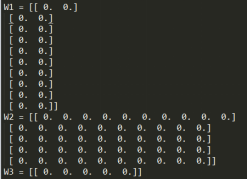
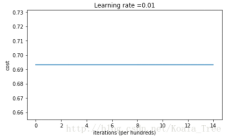
- 代价函数没有减少,0初始化导致网络无法破坏对称性
- 每一层的每个神经元都会学到相同的东西
1.4随机初始化
parameters['W'+str(l)] = np.random.randn(layers_dims[l], layers_dims[l-1])*10
parameters['b'+str(l)] = np.zeros((layers_dims[l],1))train accuracy 82.67%
test accuracy 85%
开始代价函数非常高,是因为开始时的随机权重很大
最后一层激活(sigmoid)输出的结果非常接近0或1
如果判断错误,会导致很高的代价损失
初始化不良,会导致梯度消失或梯度爆炸,会降低优化算法的速度
长时间训练网络,会得到刚好的结果,但是过大的随机初始权值会减慢优化速度
1.5he初始化
parameters['W'+str(l)] = np.random.randn(layers_dims[l], layers_dims[l-1])*np.sqrt(2./layers_dims[l-1])
parameters['b'+str(l)] = np.zeros((layers_dims[l],1))
train accuracy 99.67%
test accuracy 96%
总结

不同的初始化导致不同的结果
随机初始化用来打破对称性,并确保每个神经元学习不同的东西
不要用太大的值初始化权值
He初始化效果最佳,对于ReLU激活函数的神经网络
2、正则化
import numpy as np
import matplotlib.pyplot as plt
import sklearn
import sklearn.datasets
import scipy.io
from testCases import *
from reg_utils import *
#matplotlib inline
plt.rcParams['figure.figsize'] = (7.0, 4.0) # set default size of plots
plt.rcParams['image.interpolation'] = 'nearest'
plt.rcParams['image.cmap'] = 'gray'
# 1、下载数据
train_X, train_Y, test_X, test_Y = load_2D_dataset()
# 2-1、L2正则化: 计算损失函数
def compute_cost_with_regularization(A3, Y, parameters, lambd):
m = Y.shape[1]
W1 = parameters["W1"]
W2 = parameters["W2"]
W3 = parameters["W3"]
cross_entropy_cost = compute_cost(A3, Y)
L2_regularization_cost = (1./m*lambd/2)*(np.sum(np.square(W1))+np.sum(np.square(W2))+np.sum(np.square(W3)))
cost = cross_entropy_cost + L2_regularization_cost
return cost
# 2-2、L2正则化:反向传播
def backward_propagation_with_regularization(X, Y, cache, lambd):
m = X.shape[1]
(Z1,A1,W1,b1, Z2,A2,W2,b2, Z3,A3,W3,b3) = cache
dZ3 = A3 - Y
dW3 = 1./m * np.dot(dZ3, A2.T) + lambd/m * W3
db3 = 1./m * np.sum(dZ3, axis=1, keepdims=True)
dA2 = np.dot(W3.T, dZ3)
dZ2 = np.multiply(dA2, np.int64(A2>0))
dW2 = 1./m * np.dot(dZ2, A1.T) + lambd/m * W2
db2 = 1./m * np.sum(dZ2, axis=1, keepdims=True)
dA1 = np.dot(W2.T, dZ2)
dZ1 = np.multiply(dA1, np.int64(A1>0))
dW1 = 1./m * np.dot(dZ1, X.T) + lambd/m * W1
db1 = 1./m * np.sum(dZ1, axis=1, keepdims=True)
gradients = {"dZ3": dZ3, "dW3": dW3, "db3": db3,
"dA2": dA2, "dZ2": dZ2, "dW2": dW2, "db2": db2,
"dA1": dA1, "dZ1": dZ1, "dW1": dW1, "db1": db1}
return gradients
# 3-1、dropout:前向传播
# 三层网络结构,input---hidden---hidden---output
# dropout只应用到隐含层,不用到输入层和输出层
def forward_propagation_with_dropout(X, parameters, keep_prob=0.5):
'''
keep_prob - probability of keeping a neuron active during drop-out, scalar
'''
np.random.seed(1)
W1 = parameters["W1"]
b1 = parameters["b1"]
W2 = parameters["W2"]
b2 = parameters["b2"]
W3 = parameters["W3"]
b3 = parameters["b3"]
Z1 = np.dot(W1, X) + b1
A1 = relu(Z1)
# 第一隐含层dropout
D1 = np.random.rand(A1.shape[0],A1.shape[1])
D1 = D1 < keep_prob
A1 = A1 * D1
A1 = A1/keep_prob
Z2 = np.dot(W2, A1) + b2
A2 = relu(Z2)
# 第二隐含层dropout
D2 = np.random.rand(A2.shape[0], A2.shape[1])
D2 = D2 < keep_prob
A2 = A2 * D2
A2 = A2/keep_prob
Z3 = np.dot(W3, A2) + b3
A3 = sigmoid(Z3)
cache = (Z1,D1,A1,W1,b1, Z2,D2,A2,W2,b2, Z3,A3,W3,b3)
return A3, cache
# 3-2、dropout:反向传播
def backward_propagation_with_dropout(X, Y, cache, keep_prob=0.5):
m = X.shape[1]
(Z1, D1, A1, W1, b1, Z2, D2, A2, W2, b2, Z3, A3, W3, b3) = cache
dZ3 = A3 - Y
dW3 = 1./m * np.dot(dZ3, A2.T)
db3 = 1./m * np.sum(dZ3, axis=1, keepdims = True)
dA2 = np.dot(W3.T, dZ3)
dA2 = dA2 * D2
dA2 = dA2 / keep_prob
dZ2 = np.multiply(dA2, np.int64(A2 > 0))
dW2 = 1./m * np.dot(dZ2, A1.T)
db2 = 1./m * np.sum(dZ2, axis=1, keepdims = True)
dA1 = np.dot(W2.T, dZ2)
dA1 = dA1 * D1
dA1 = dA1 / keep_prob
dZ1 = np.multiply(dA1, np.int64(A1 > 0))
dW1 = 1./m * np.dot(dZ1, X.T)
db1 = 1./m * np.sum(dZ1, axis=1, keepdims = True)
gradients = {"dZ3": dZ3, "dW3": dW3, "db3": db3,"dA2": dA2,
"dZ2": dZ2, "dW2": dW2, "db2": db2, "dA1": dA1,
"dZ1": dZ1, "dW1": dW1, "db1": db1}
return gradients
# 4、神经网络模型
def model(X, Y, learning_rate=0.3, num_iterations=10000, print_cost=True, lambd=0, keep_prob=1):
"""
Implements a three-layer neural network: LINEAR->RELU->LINEAR->RELU->LINEAR->SIGMOID.
Arguments:
X -- input data, of shape (input size, number of examples)
Y -- true "label" vector (1 for blue dot / 0 for red dot), of shape (output size, number of examples)
learning_rate -- learning rate of the optimization
num_iterations -- number of iterations of the optimization loop
print_cost -- If True, print the cost every 10000 iterations
lambd -- regularization hyperparameter, scalar
keep_prob - probability of keeping a neuron active during drop-out, scalar.
Returns:
parameters -- parameters learned by the model. They can then be used to predict.
"""
grads = {}
costs = []
m = X.shape[1]
layers_dims = [X.shape[0], 20, 3, 1]
parameters = initialize_parameters(layers_dims)
for i in range(0, num_iterations):
# (1)前向传播
# 是否使用 Dropout
if keep_prob == 1:
a3,cache = forward_propagation(X, parameters)
elif keep_prob < 1:
a3,cache = forward_propagation_with_dropout(X, parameters, keep_prob)
# (2)损失函数
# 是否正则化
if lambd == 0:
cost = compute_cost(a3, Y)
else:
cost = compute_cost_with_regularization(a3, Y, parameters, lambd)
# (3)后向传播
assert(lambd==0 or keep_prob==1) # 正则化和 Dropout 不能同时使用
if lambd==0 and keep_prob==1:
grads = backward_propagation(X, Y, cache)
elif lambd != 0:
grads = backward_propagation_with_regularization(X, Y, cache, lambd)
elif keep_prob < 1:
grads = backward_propagation_with_dropout(X, Y, cache, keep_prob)
# (4)更新参数
parameters = update_parameters(parameters, grads, learning_rate)
# (5)每迭代1000步,打印一次损失函数
if print_cost and i%1000==0:
costs.append(cost)
print("cost after iteration {}:{}".format(i, cost))
# 画出costs
plt.plot(costs)
plt.ylabel("cost")
plt.xlabel("iterations (per 100)")
plt.title("learning rate = " + str(learning_rate))
plt.show()
return parameters
# 5、训练模型,观察训练集、测试集正确率
# 依次是:无正则化、L2正则化
# 训练模型 =================================================== 选择模式
parameters = model(train_X, train_Y, num_iterations=10000,lambd=0, keep_prob=1)
print ("On the training set:")
predictions_train = predict(train_X, train_Y, parameters)
print ("On the test set:")
predictions_test = predict(test_X, test_Y, parameters)
# 画出分界面
plt.title("Model without regularization")
axes = plt.gca()
axes.set_xlim([-0.75,0.40])
axes.set_ylim([-0.75,0.65])
plot_decision_boundary(lambda x: predict_dec(parameters, x.T), train_X, train_Y)
2.1无正则化

非正则化模型显然过拟合了,这是适合的嘈杂点,
以下两种方法减少过拟合
2.2L2正则化
损失函数增加了一项
Lambda=0.7
Lambda是一个超参数,能使用开发集调整
L2正则化能使分界面平滑,
如果lambda太大,会导致“过度平滑”导致高偏差模型

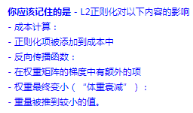
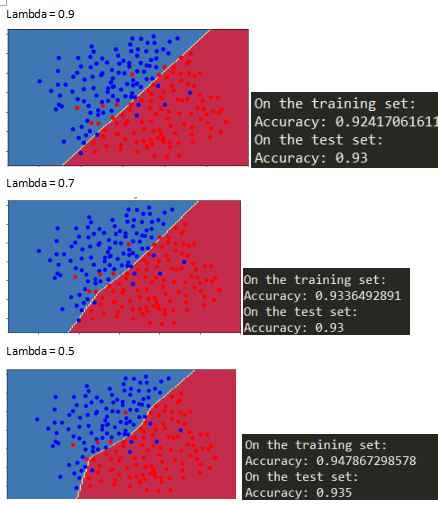
2.3Dropout正则化
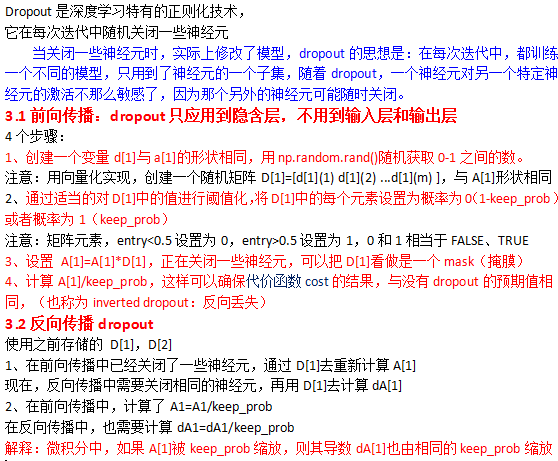

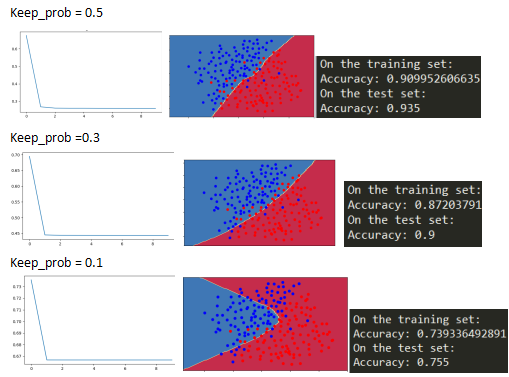
总结

正则化损害了训练集的性能,这是因为它限制了神经网络的能力,为了防止训练集过拟合。
但是它最终提供了更好的测试准确率
正则化帮助减少过拟合
正则化使得权值更小
L2正则化和Dropout是两个很有效的正则化技术
3、梯度检验
import numpy as np
import matplotlib.pyplot as plt
import sklearn
import sklearn.datasets
import scipy.io
from testCases import *
from gc_utils import *
# 1-1 、计算一维线性前向传播 J(theta) = theta * x
def forward_propagation(x, theta):
"""
Implement the linear forward propagation (compute J),(J(theta) = theta * x)
Arguments:
x -- a real-valued input
theta -- our parameter, a real number as well
Returns:
J -- the value of function J, computed using the formula J(theta) = theta * x
"""
J = theta * x
return J
# 1-2、计算一维反向传播(导数/梯度) dtheta = J(theat)'
def backward_propagation(x, theta):
"""
Returns:
dtheta -- the gradient of the cost with respect to theta
"""
dtheta = x
return dtheta
# 1-3、一维梯度检验
def gradient_check(x, theta, epsilon=1e-7):
"""
Implement the backward propagation
Arguments:
x -- a real-valued input
theta -- our parameter, a real number as well
epsilon -- tiny shift to the input to compute approximated gradient
Returns:
difference -- approximated gradient and the backward propagation gradient
"""
# 计算 gradapprox , epsilon足够小对于limit来说
theta_plus = theta + epsilon
theta_minus = theta - epsilon
J_plus = forward_propagation(x, theta_plus)
J_minus = forward_propagation(x, theta_minus)
gradapprox = (J_plus - J_minus)/(2 * epsilon)
# 计算 grad
grad = backward_propagation(x, theta)
# 计算 difference
numerator = np.linalg.norm(grad - gradapprox) # 分子
denominator = np.linalg.norm(grad) + np.linalg.norm(gradapprox) # 分母
difference = numerator/denominator
if difference < 1e-7:
print("the gradient is correct!")
else:
print("the gradient is wrong!")
return difference
# 2-1 计算N维前向传播
def forward_propagation_n(X, Y, parameters):
"""
Implements the forward propagation (and computes the cost) presented in Figure 3.
Arguments:
X -- training set for m examples
Y -- labels for m examples
parameters -- python dictionary containing your parameters "W1", "b1", "W2", "b2", "W3", "b3":
W1 -- weight matrix of shape (5, 4)
b1 -- bias vector of shape (5, 1)
W2 -- weight matrix of shape (3, 5)
b2 -- bias vector of shape (3, 1)
W3 -- weight matrix of shape (1, 3)
b3 -- bias vector of shape (1, 1)
Returns:
cost -- the cost function (logistic cost for one example)
"""
# retrieve parameters
m = X.shape[1]
W1 = parameters["W1"]
b1 = parameters["b1"]
W2 = parameters["W2"]
b2 = parameters["b2"]
W3 = parameters["W3"]
b3 = parameters["b3"]
# LINEAR -> RELU -> LINEAR -> RELU -> LINEAR -> SIGMOID
Z1 = np.dot(W1, X) + b1
A1 = relu(Z1)
Z2 = np.dot(W2, A1) + b2
A2 = relu(Z2)
Z3 = np.dot(W3, A2) + b3
A3 = sigmoid(Z3)
# Cost
logprobs = np.multiply(-np.log(A3),Y) + np.multiply(-np.log(1 - A3), 1 - Y)
cost = 1./m * np.sum(logprobs)
cache = (Z1, A1, W1, b1, Z2, A2, W2, b2, Z3, A3, W3, b3)
return cost, cache
# 2-2 计算N维反向传播
def backward_propagation_n(X, Y, cache):
"""
Implement the backward propagation presented in figure 2.
Arguments:
X -- input datapoint, of shape (input size, 1)
Y -- true "label"
cache -- cache output from forward_propagation_n()
Returns:
gradients -- A dictionary with the gradients of the cost with respect to each parameter, activation and pre-activation variables.
"""
m = X.shape[1]
(Z1, A1, W1, b1, Z2, A2, W2, b2, Z3, A3, W3, b3) = cache
dZ3 = A3 - Y
dW3 = 1./m * np.dot(dZ3, A2.T)
db3 = 1./m * np.sum(dZ3, axis=1, keepdims = True)
dA2 = np.dot(W3.T, dZ3)
dZ2 = np.multiply(dA2, np.int64(A2 > 0))
dW2 = 1./m * np.dot(dZ2, A1.T)
db2 = 1./m * np.sum(dZ2, axis=1, keepdims = True)
dA1 = np.dot(W2.T, dZ2)
dZ1 = np.multiply(dA1, np.int64(A1 > 0))
dW1 = 1./m * np.dot(dZ1, X.T)
db1 = 1./m * np.sum(dZ1, axis=1, keepdims = True)
gradients = {"dZ3": dZ3, "dW3": dW3, "db3": db3,
"dA2": dA2, "dZ2": dZ2, "dW2": dW2, "db2": db2,
"dA1": dA1, "dZ1": dZ1, "dW1": dW1, "db1": db1}
return gradients
# 2-3、N维梯度检验
def gradient_check_n(parameters, gradients, X, Y, epsilon=1e-7):
"""
Checks if backward_propagation_n computes correctly the gradient
Arguments:
parameters -- python dictionary containing your parameters "W1", "b1", "W2", "b2", "W3", "b3":
grad -- output of backward_propagation_n
x -- input, of shape (input size, 1)
y -- true "label"
epsilon -- tiny shift to the input to compute approximated gradient
Returns:
difference --the approximated gradient and the backward propagation gradient
"""
# 设置变量
parameters_values, _ = dictionary_to_vector(parameters)
grad = gradients_to_vector(gradients)
num_parameters = parameters_values.shape[0]
J_plus = np.zeros((num_parameters,1))
J_minus = np.zeros((num_parameters,1))
gradapprox = np.zeros((num_parameters,1))
# 计算 gradapprox
for i in range(num_parameters):
theta_plus = np.copy(parameters_values)
theta_plus[i][0] = theta_plus[i][0] + epsilon
J_plus[i], _ = forward_propagation_n(X, Y, vector_to_dictionary(theta_plus))
theta_minus = np.copy(parameters_values)
theta_minus[i][0] = theta_minus[i][0] - epsilon
J_minus[i], _ = forward_propagation_n(X, Y, vector_to_dictionary(theta_minus))
gradapprox[i] = (J_plus[i] - J_minus[i])/(2. * epsilon)
numerator = np.linalg.norm(grad - gradapprox)
denominator = np.linalg.norm(grad) + np.linalg.norm(gradapprox)
difference = numerator/denominator
if difference > 1e-7:
print(difference)
print ("There is a mistake in the backward propagation!")
else:
print(difference)
print ("Your backward propagation works perfectly fine!")
return difference
X, Y, parameters = gradient_check_n_test_case()
cost, cache = forward_propagation_n(X, Y, parameters)
gradients = backward_propagation_n(X, Y, cache)
difference = gradient_check_n(parameters, gradients, X, Y)
前向传播相对容易实现,默认做的是正确的,验证反向传播
dJ/dw
d
J
/
d
w
的正确性
一维梯度检验
N维梯度检验
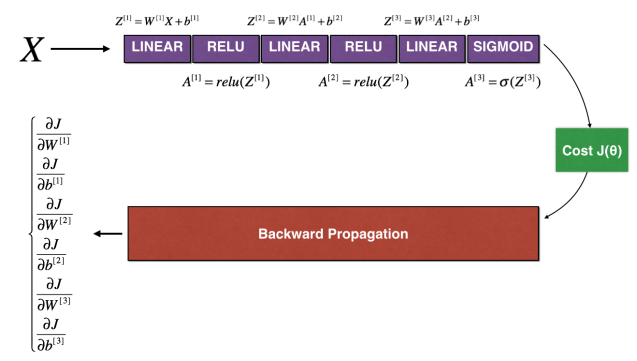
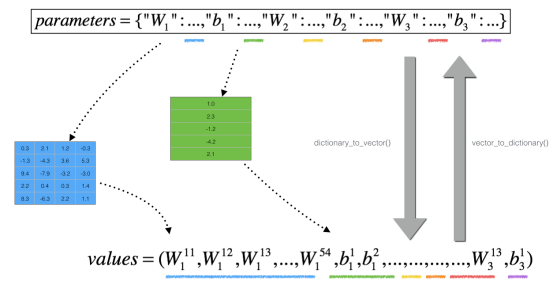


注意:
梯度检验很慢,近似梯度计算成本高。
所以不能每一步训练都进行梯度检验,只需要检验几次。(用来验证代码的正确性)
梯度检验不适用于dropout,应该使用完整的网络检验梯度,然后再添加dropout
梯度检验,计算梯度近似值、反向传播梯度之间的接近程度








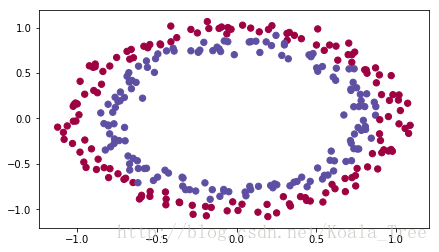
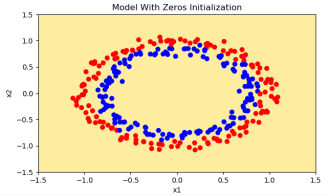


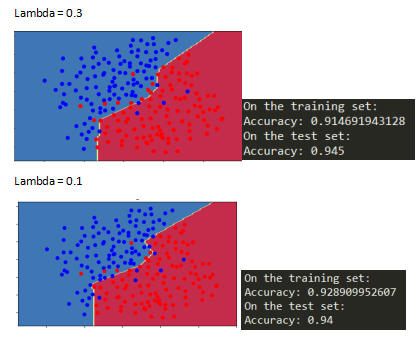
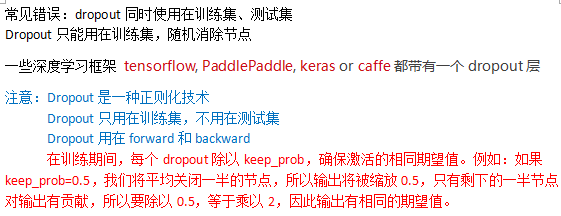














 1327
1327

 被折叠的 条评论
为什么被折叠?
被折叠的 条评论
为什么被折叠?








